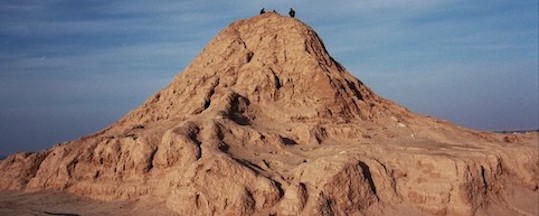You are seeing an unstyled version of this site. If this is because you are using an older web browser, we recommend that you upgrade to a modern, standards-compliant browser such as FireFox [http://www.getfirefox.com/], which is available free of charge for Windows, Mac and Linux.
The Aššur-matu-taqqin Archive

View of the ziggurat of the god Aššur at Assur. Photo credit: Marjon Verburg [https://www.livius.org/pictures/iraq/qalat-serqat-assur/assur-ziggurat/].
This sub-project of the Archival Texts of the Assyrian Empire (ATAE) [/atae/index.html] Project includes open-access versions of the thirty-four Neo-Assyrian texts (with English translations) edited in Ali Yaseen Ahmad's article "The Archive of Aššur-mātu-taqqin Found in the New Town of Aššur and Dated Mainly by Post-canonical Eponyms," al-Rāfidān 17 (1996), pp. 207–288.
All of the texts included here were discovered under a door socket of a private house located in the New City (Akkadian ālu eššu) of Assur (Qalat Sherqat). Most of this group of texts are legal documents from the post-canonical period (after 648 BC). This small group of tablets — which were discovered during excavations by the State Organization for Antiquities and Heritage in 1979–80, not far south of the Parthian Palace, against the western wall of the New City — form an archive of the treasurer Aššur-matu-taqqin, son of Mannu-ki-Arabil, a man active during the reign of Ashurbanipal (r. 668–ca. 631 BC) and his successors Aššur-etel-ilāni (r. ca. 630–627 BC) and Sîn-šarru-iškun (r. ca. 626–612 BC).
The open-access editions of al-Rafidan 17 were adapted and revised from the Neo-Assyrian Text Corpus (NATC) database and the source publication by Jamie Novotny and Poppy Tushingham. Please note that work on the texts of the Aššur-matu-taqqin Archive is still in the early stages of preparation. As of March 2021, the corpus has not yet been lemmatized (linguistically annotated). Please bear with us while we work on this material.
Click here [/atae/rfdn17/pager] to browse the Aššur-matu-taqqin Archive corpus.
ATAE is a key component of the Archival Texts of the Middle East in Antiquity (ATMEA) sub-project of the LMU-Munich-based Munich Open-access Cuneiform Corpus Initiative [https://www.en.ag.geschichte.uni-muenchen.de/research/mocci/index.html] (MOCCI; directed by Karen Radner and Jamie Novotny). Funding for the ATAE corpus project has been provided by LMU Munich and the Alexander von Humboldt Foundation (through the establishment of the Alexander von Humboldt Chair for Ancient History of the Near and Middle East).
For further details, see the "About the project" [/atae/abouttheproject/index.html] page.

Jamie Novotny
Jamie Novotny, 'The Aššur-matu-taqqin Archive', The Aššur-matu-taqqin Archive (al-Rafidan 17), The Archive of Aššur-matu-taqqin (al-Rafidan 17). Original publication: 1996; online contents: ATAE/al-Rafidan 17 Project, a sub-project of MOCCI, 2023 [http://oracc.org/atae/rfdn17/]